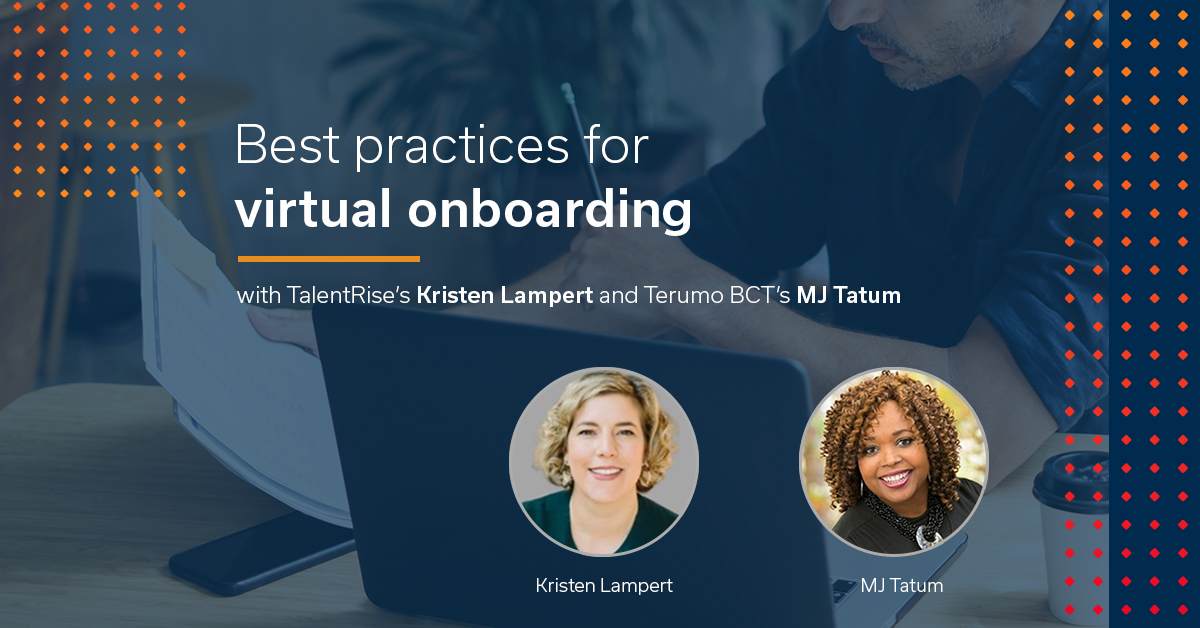In a COVID-19 world, most new employees will have to be onboarded virtually. This presents a host of challenges, as many onboarding activities, such as orientation, training, and drug screenings, are normally done in person.
To overcome these difficulties, we recently hosted a webinar to discuss virtual onboarding best practices that will help companies keep their employees engaged and productive during COVID-19. The discussion – which featured TalentRise’s Kristen Lampert and Terumo BCT’s MJ Tatum – covered topics such as management styles, technology platforms, communication strategies, and many others.
If you missed the webinar, don’t worry. We have the highlights, and we’ve presented them below with five key takeaways that will optimize your virtual onboarding approach:
1. Be Understanding
Understand that during this time, new employees might be experiencing heightened stress or anxiety. Realize that workers may have extra responsibilities, like childcare, that they have to tend to throughout the day. Be caring and empathetic in your management approach to gain the respect and trust of your new hires.
Additionally, understand that certain background check requirements might be difficult or impossible to complete right now. For example, new employees may not currently be comfortable or able to perform in-person drug screenings. Consider waiving drug screenings temporarily so you can onboard new employees safely and efficiently.
2. Tailor Your Performance Management Approach
Treat all new employees as individuals. Take into account their preferences, and tailor your management approach accordingly. Some employees may prefer daily touch bases, while others prefer less frequent communication. Customizing your management style to fit your employees’ needs will help them feel more comfortable and be more productive.
3. Utilize Technology Platforms to Maintain Engagement
Tools like Microsoft Teams, Slack, Google Chat, and Zoom can be useful technologies to stay in touch with your remote workforce. When onboarding new employees, it’s critically important to make them feel like part of the team. Engage them using the technology you have at your disposal, and make sure they can stay connected with their team.
Also, use your intranet to provide new employees with resources that will help them perform their jobs and navigate this difficult time. You could create a COVID-19-specific page on your intranet with information on how to stay safe, recommendations on how to effectively work from home, and health and wellness tips – all of which will keep your workforce safe and satisfied.
4. Keep Spirits High
Coronavirus may have you down, but it’s important to keep morale high. Come up with creative ways to have fun with your team. You could create chat channels dedicated specifically to sharing funny memes or happy music. Consider hosting a virtual happy hour with your team over video conference. Whatever you choose to do, keeping spirits high will help recently onboarded employees feel at ease with their new jobs and connected to their new teammates.
5. Communicate, Communicate, Communicate
Open, honest communication will be key to engaging all employees, especially new hires. Send regular communications about company updates, and schedule frequent check-ins to make sure everything is going smoothly. Avoid over-communication and micromanagement, but let your employees know you’re there to keep them informed and help in any way you can.
In addition, establish communications plans that your hiring managers, HR, and IT departments should follow when bringing on a new employee. This will help streamline processes such as new-hire paperwork and equipment delivery/setup. During this time of uncertainty, creating communications plans ahead of time will ensure that you’re prepared to bring on workers quickly and without roadblocks.
While we’re all experiencing some disruption to our normal working lives, innovation and collaboration will help us move forward successfully. We hope that the webinar and this information will assist your virtual onboarding efforts and optimize the management of your remote workforce.
If you’d like more insights into how to better engage and manage your workforce, visit the TalentRise Facebook, Twitter, and LinkedIn.
If you have more questions about virtual onboarding, don’t hesitate to connect with Kristen Lampert, the webinar’s host, on LinkedIn. You can also connect with the webinar’s featured guest, Emjae Tatum, on LinkedIn and Instagram.




